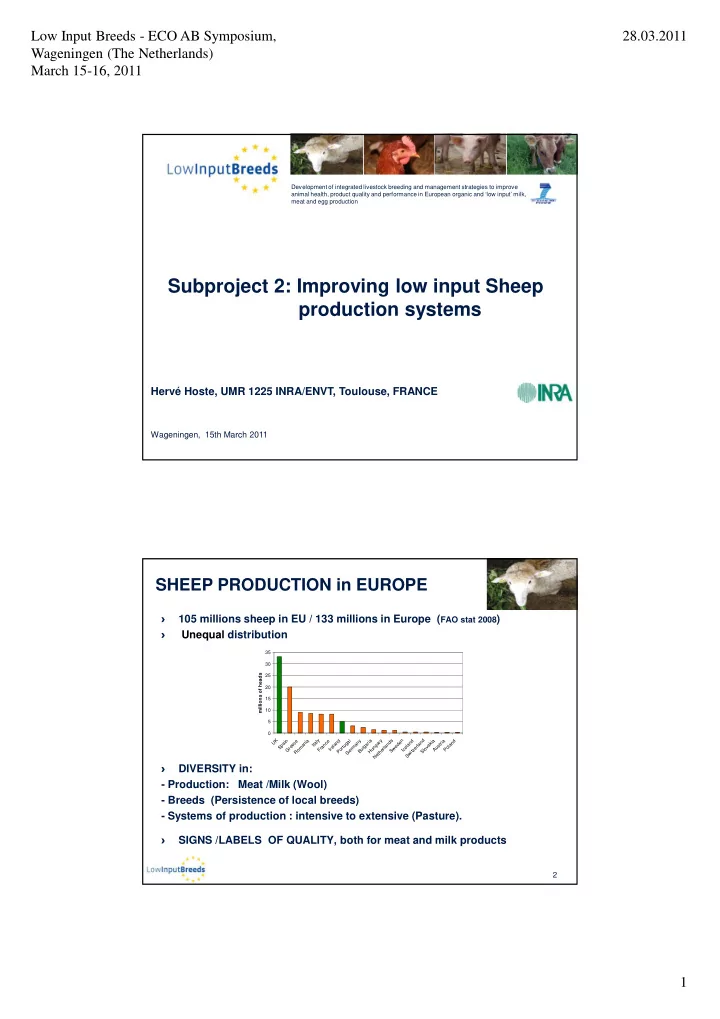

Low Input Breeds - ECO AB Symposium, 28.03.2011 Wageningen (The Netherlands) March 15-16, 2011 Development of integrated livestock breeding and management strategies to improve animal health, product quality and performance in European organic and ‘low input’ milk, meat and egg production Subproject 2: Improving low input Sheep production systems Hervé Hoste, UMR 1225 INRA/ENVT, Toulouse, FRANCE Wageningen, 15th March 2011 SHEEP PRODUCTION in EUROPE � 105 millions sheep in EU / 133 millions in Europe ( FAO stat 2008 ) � Unequal distribution 35 30 millions of heads 25 20 15 10 5 0 K y d n e a e d l y a y s n d a a d U i i a l n a n i r d e n n i i n a c n c g r a k r e a t n a a a n d a a a t a p e I u g g a e l s S m a e l t m n e l r v u o l r r r l l w e o G o F r o r u u e r c z A P I P e B H S I S l R G h t w i e t S N � DIVERSITY in: - Production: Meat /Milk (Wool) - Breeds (Persistence of local breeds) - Systems of production : intensive to extensive (Pasture). � SIGNS /LABELS OF QUALITY, both for meat and milk products 2 1
Low Input Breeds - ECO AB Symposium, 28.03.2011 Wageningen (The Netherlands) March 15-16, 2011 Subproject 2: Objectives Genetic factors (Local breeds) Production Nutrition (Grazing regimes) Environment (Stress) ( Grazing management) (Abiotic and biotic factors) (Tannin rich forages ) Mediterranean and Mountainous regions 3 Subproject 2: Teams Sheep SubProject 1. FIBL (Switzerland) 2. INRA (France) 3. NAGREF (Greece) 1 2 2 4. Univ Catania (Italy) 3 5. Univ. Lincoln (NZ) 4 3 2
Low Input Breeds - ECO AB Symposium, 28.03.2011 Wageningen (The Netherlands) March 15-16, 2011 Subproject 2: Objectives 1.To examine the genetics of sheep resistance to abiotic and biotic factors 2. To develop integrated methods of control of GI Nematodes 3. To examine feeding and breed factors affecting the meat quality 5 Subproject 2 : Objectives 2.1 Development of WITHIN BREED SELECTION systems to improve abiotic and biotic stress resistance and performance traits; comparing marker assisted and traditional quantitative genetic selection systems for functional traits. 2.1.1. Phenotyping of Sfakiano sheep for biotic (nematodes, mastitis) and abiotic (heat) stress resistance. Dr S. Sotiraki (NAGREF) / Collaboration with stakeholders in Creta 2.1.2. Genotyping of sheep breeds used in different macro-climatic zones of Europe (Greece, Switzerland, France, and NZ ) Dr S. Sotiraki (NAGREF), Dr V Maurer, F Heckendorn and S. Werne (FiBL), Dr H. Hoste and S. Prache (INRA); Pr J. Hickford (Lincoln Univ.) 6 3
Low Input Breeds - ECO AB Symposium, 28.03.2011 Wageningen (The Netherlands) March 15-16, 2011 Subproject 2: Objectives 2.2 Development of improved ENDOPARASITE MANAGEMENT STRATEGIES based on integrating: (a) feed supplementation with tannin rich (TR) forages; (b) strategic use of clean pastures and/or (c) the use of parasite tolerant breeds. 2.2.1 CONTROLLED STUDIES: Quantification of (a) condensed tannin profiles in TR-forages and concentrate feeds, (b) ‘in vitro’ and ‘in vivo’ anthelmintic (AH) activity and (c) the potential contribution of non-tannin compounds to AH activity. 2.2.2 FIELD TRIALS (Mediterranean production systems): Effects of (and interaction between) (a) different TR feeding regimes and (b) Sfakiano sheep genotypes on animal health, yield and product quality. 2.2.3 FIELD TRIALS (Mountainous/Alpine production systems) : Effects of (and interaction between) (a) different TR feeding regimes (b) grazing regimes and (c) different sheep genotypes on animal health, yield and product quality 7 Subproject 2: Objectives 2.3 Development of strategies to improve LAMB MEAT QUALITY in sheep production systems based on optimising (a) TF feed supplements (b) grazing regimes and/or (c) the use of stress tolerant breed 2.3.1 FIELD TRIALS and LABORATORY STUDIES Effects of (and interaction between) using (a) robust breeds/genotypes (b) TF-feed supplementation and (c) different grazing regimes on carcass and meat quality (including samples from trials under WP2.2.). • Two studies in mountainous conditions (INRA Clermont Ferrand) S. Prache, J. Ballet) (FiBL V. Maurer , F Heckendorn and S Werne) • One study in Mediterranean conditions (Univ Catania) A Priollo, V. Vasta 8 4
Low Input Breeds - ECO AB Symposium, 28.03.2011 Wageningen (The Netherlands) March 15-16, 2011 The authors gratefully acknowledge co-funding from the European Commission, under the Seventh Framework Programme for Research and Technological Development, for the Collaborative Project LowInputBreeds (Grant agreement No 222623) 9 5
Recommend
More recommend